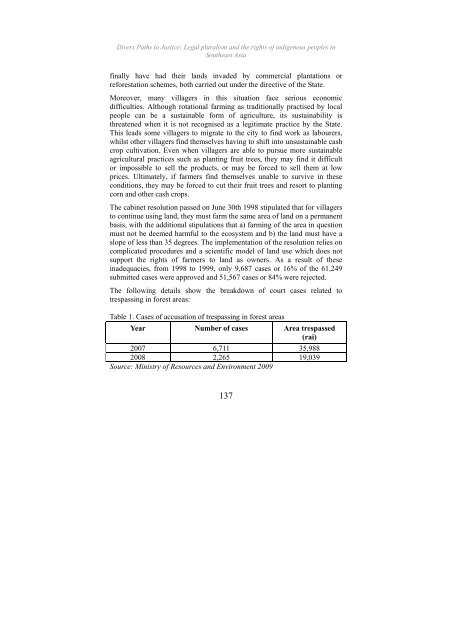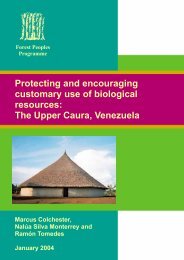Divers Paths to Justice - English - Forest Peoples Programme
Divers Paths to Justice - English - Forest Peoples Programme
Divers Paths to Justice - English - Forest Peoples Programme
You also want an ePaper? Increase the reach of your titles
YUMPU automatically turns print PDFs into web optimized ePapers that Google loves.
<strong>Divers</strong> <strong>Paths</strong> <strong>to</strong> <strong>Justice</strong>: Legal pluralism and the rights of indigenous peoples inSoutheast Asiafinally have had their lands invaded by commercial plantations orreforestation schemes, both carried out under the directive of the State.Moreover, many villagers in this situation face serious economicdifficulties. Although rotational farming as traditionally practised by localpeople can be a sustainable form of agriculture, its sustainability isthreatened when it is not recognised as a legitimate practice by the State.This leads some villagers <strong>to</strong> migrate <strong>to</strong> the city <strong>to</strong> find work as labourers,whilst other villagers find themselves having <strong>to</strong> shift in<strong>to</strong> unsustainable cashcrop cultivation. Even when villagers are able <strong>to</strong> pursue more sustainableagricultural practices such as planting fruit trees, they may find it difficul<strong>to</strong>r impossible <strong>to</strong> sell the products, or may be forced <strong>to</strong> sell them at lowprices. Ultimately, if farmers find themselves unable <strong>to</strong> survive in theseconditions, they may be forced <strong>to</strong> cut their fruit trees and resort <strong>to</strong> plantingcorn and other cash crops.The cabinet resolution passed on June 30th 1998 stipulated that for villagers<strong>to</strong> continue using land, they must farm the same area of land on a permanentbasis, with the additional stipulations that a) farming of the area in questionmust not be deemed harmful <strong>to</strong> the ecosystem and b) the land must have aslope of less than 35 degrees. The implementation of the resolution relies oncomplicated procedures and a scientific model of land use which does notsupport the rights of farmers <strong>to</strong> land as owners. As a result of theseinadequacies, from 1998 <strong>to</strong> 1999, only 9,687 cases or 16% of the 61,249submitted cases were approved and 51,567 cases or 84% were rejected.The following details show the breakdown of court cases related <strong>to</strong>trespassing in forest areas:Table 1. Cases of accusation of trespassing in forest areasYear Number of cases Area trespassed(rai)2007 6,711 35,9882008 2,265 19,039Source: Ministry of Resources and Environment 2009137
















